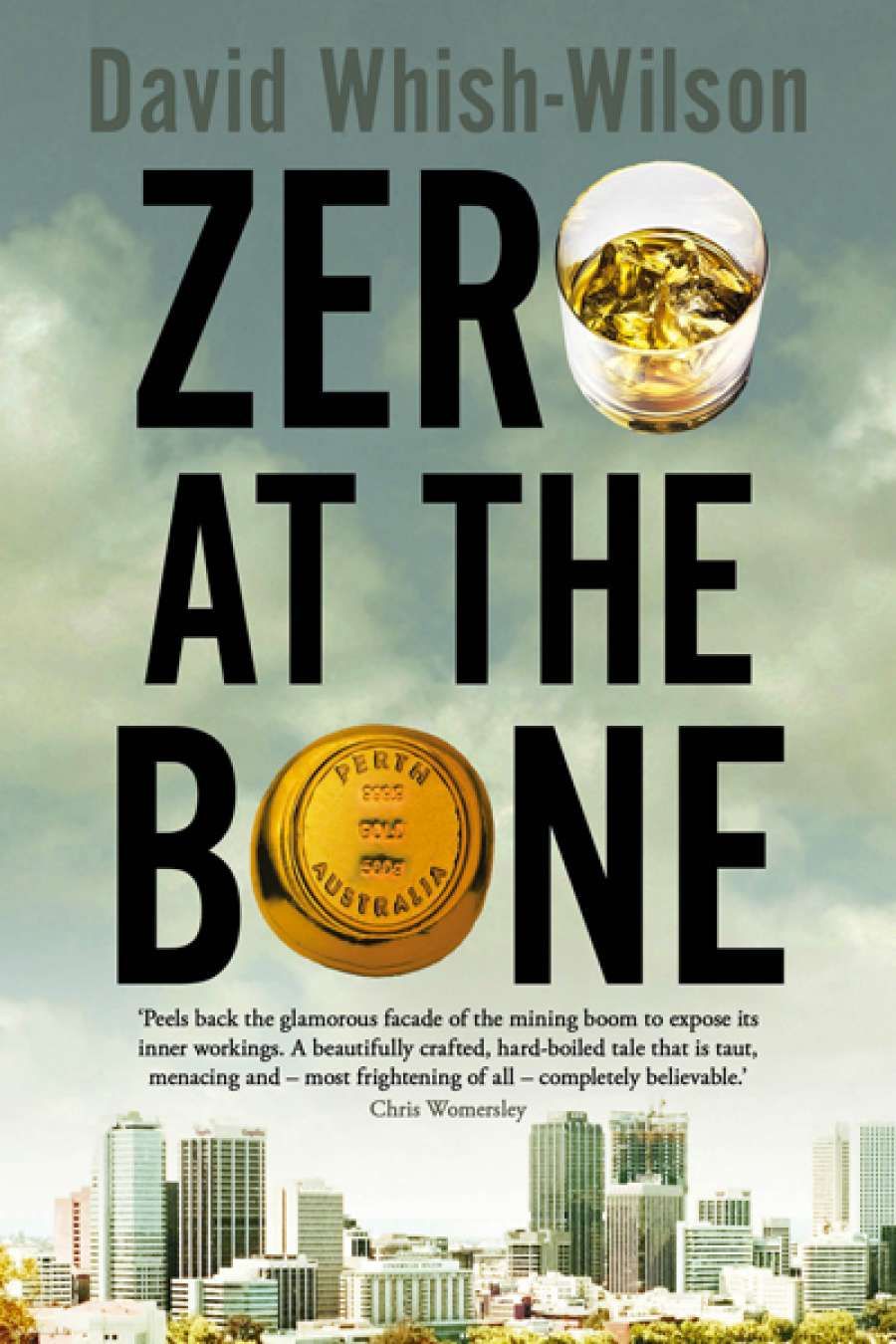
- Free Article: No
- Contents Category: Fiction
- Custom Article Title: Wendy Were reviews 'Zero at the Bone'
- Review Article: Yes
- Article Title: WA Inc.
- Online Only: No
- Custom Highlight Text:
In Zero at the Bone, David Whish-Wilson envisions Perth in 1979 at the height of a major gold mining revival stimulated by price increases associated with the end of the gold standard in 1971. Perth is booming, and the culture of greed and excess that will characterise the 1980s is already well entrenched.
- Book 1 Title: Zero at the Bone
- Book 1 Biblio: Viking, $29.99 pb, 288 pp, 9780670077533
Zero at the Bone opens with a methodical suicide, uncovering the reasons behind which drives the plot. The novel is the sequel to Whish-Wilson’s acclaimed début Line of Sight (2010), which centred on an actual murder of a brothel madam in 1975, and has the same protagonist, Frank Swann. After his whistle-blowing prompted a royal commission into police corruption, the former detective superintendent has been forced to resign and is now eking out a living as a private investigator. His stance against corruption has earned him far more enemies than friends: the men he attempted to expose are seeking retribution, and recent indiscretions have taken a toll on his personal life. Beset from all sides, he is offered a job investigating the apparent suicide of Max Henderson, a celebrated geologist. Seemingly convinced to take up the work in no small part by his physical attraction to the dead man’s widow, Swann soon determines that Henderson was one of a group of directors of a gold-lease consortium poised to strike it rich in the goldfields. Further, the company kept by the geologist was highly questionable: the other directors are an unsavoury mix of mafia bosses, career criminals, and corrupt public officers. Determining why Henderson took his life leads Swann down a dangerous path, with some satisfying turns holding narrative interest in a complex plot.
Whish-Wilson strives to provide a vivid depiction of Perth at the peak of the 1970s boom and of the individuals who inhabited that time and space. The book teems with local colour, almost relentlessly so. Street names, suburbs, and landmarks pepper the text as Frank traverses the city and suburbs:
The sun slid across the Indian Ocean, leaving tracer lines of amethyst and orange over the coastal heath that marked the fringes of suburban Swanbourne. Swann passed the Graylands Asylum and the Karrakatta infantry barracks, and headed down to the rifle range nestled amongst the dunes, where the RSL was situated. Perhaps if he was lucky he’d get a swim at Cottesloe before dark …
Similarly, political and current events such as the sesquicentennial celebrations serve to temporally locate the reader. This heavily researched and painstaking attention to detail skilfully captures the essence of Perth in the late 1970s and bodes well for Whish-Wilson’s forthcoming contribution to the NewSouth Books city series.
Zero at the Bone is classic crime noir. Bad cops, jewel thieves, bent bookies and horse trainers, corrupt politicians, mob bosses, and junkies abound. Frank Swann is a flawed but sympathetic anti-hero whose experience has fostered a jaundiced view of government, power, and the law. A cynical idealist, he knows that his society is corrupt, but continues to hold a belief in justice and his personal responsibility to do whatever is necessary to see that it is done. This sees him make numerous dubious decisions, often at the expense of his own well-being, but ultimately he is a likeable and convincing character.
Whish-Wilson’s novel offers some insight into the social and moral climate not of only the 1970s, but also of booming present-day Perth. The city’s evolution is inextricably linked to mining. Its history can be traced by cyclical adjustment to boom and bust. This is written into the architecture, with major infrastructure projects mirroring the gold rushes of the latter nineteenth century; the nickel boom of the 1960s and 1970s; and the current iron ore boom that has spurred major projects across the city. This boom and bust cycle has rendered the city as a palimpsest: a recent study of a central site in Perth counted seventeen buildings erected on one site over the city’s 182-year existence. For a local reader, Whish-Wilson’s insistence on referencing Perth as it was thirty years ago highlights what has endured and what has slipped away.
People continue to flock to Western Australia to share in the wealth boom generated by mining. These days the ubiquity of high-visibility clothingis no longer the butt of jokes, but goes unremarked. A corollary to immense wealth is greed and it is this vice that drives Zero at the Bone. Almost everyone is intent on cashing in and this is the basis of some implicit judgement. The get-rich-quickly mentality leads to a culture of crooked cops and underworld figures who openly mingle with shady government officials in an orgy of crime and corruption. Violent crime isn’t sensationalised but is regularly represented as a means to obtaining wealth. And the casualties of the cash grab – the homeless, the junkies, the disenfranchised – are not forgotten.
Whish-Wilson has crafted another satisfying novel that will particularly resonate with those familiar with Western Australia. It also contributes to the wealth of impressive crime fiction currently being produced in the country. Frank Swann seems destined to return: the collusion of corrupt government and police officials with organised crime and big business leaves a door wide open for a subsequent book leading into the WA Inc. era of the 1980s.


Comments powered by CComment